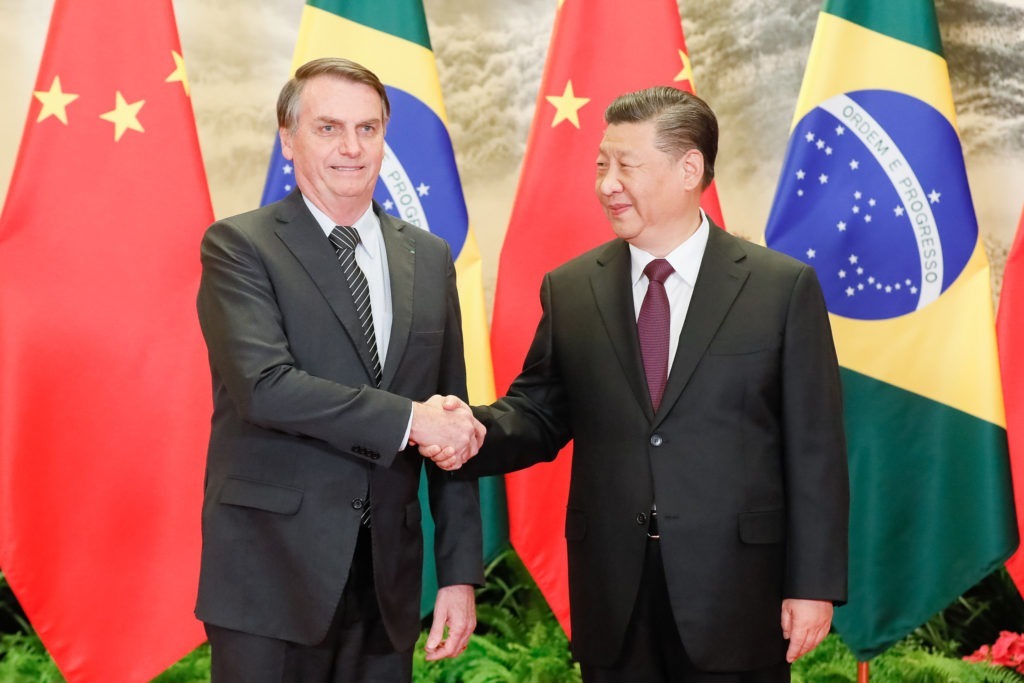Great Power Competition Heats up in Latin America

By Thomas Lambert
Staff Writer
31/3/2022

Argentinian President Alberto Fernández with Chinese President Xi Jinping in Beijing during the 2022 Winter Olympics (Picture Credit: Casa Rosada)
Something strange is happening in “America’s backyard.” For 200 years, the US has taken its hegemony over Latin America largely for granted – from the possessiveness of the Monroe Doctrine to the casual military interventions that punctuated the Cold War. But things might be changing. By almost every measure imaginable – trade balances to joint industrial ventures, visits from heads of state to the destinations of students studying abroad – Latin Americans are coming under the thrall of a new superpower: China.
As with most Chinese diplomacy, the courtship has thus far been mainly economic. China’s Belt and Road initiative (BRI) has been the subject of many frenzied headlines for its incursions into Africa and the Indian subcontinent, but its expansion into Latin America has received little attention. Today, Brazil, Uruguay, Argentina, and Chile all report China, not the US, as their largest non-Latin American trading partner. In Brazil, Latin America’s largest economy, bilateral trade with China rose from $2 billion in 2000 to $100 billion before the pandemic in 2020, and most other countries in the region are following suit.
China is also the main importer of a number of national staples: Argentinian and Uruguayan beef, Chilean copper, Colombian oil, and Brazilian soya. Not only do these sectors account for a huge proportion of these countries’ GDP, they also have extremely powerful political lobbies. Because of this, the ruling classes that have traditionally been among the US’ strongest advocates – Argentinian and Uruguayan ranchers, Colombian oil barons, Brazilian plantation owners – now have an increasingly large stake in good relations with China.
Because of Chinese trade, Latin America’s ruling classes now have an increasingly large stake in good relations with China.
China hasn’t only been courting moguls and magnates. There has also been a concerted effort to win over domestic populists by offering a challenge to the region’s other, more established hegemon. In countries like Chile, Argentina, and Nicaragua, which suffered immensely from counterrevolutionary meddling during the Cold War, any attempt to undermine US influence is likely to be popular, especially with the political left; and even liberal voters soured on America during the administration of Donald Trump, who only visited the region once during his time in office, and demonized Latinos for political mileage. The Chinese, by contrast, are not only free of Cold War baggage (having pioneered the “Third Worldism” so beloved of Hugo Chávez and Che Guevara), but seem willing to support populist schemes that the US won’t touch: publicly abetting Nicolas Maduro’s Venezuelan government in 2020, and even going so far as to back Argentina’s claim to the Falkland Islands earlier this year.

Marxist Chilean President Salvador Allende, who the CIA helped depose during the Cold War (Picture Credit: Fundación GAP)
In doing this, China manages to pander to precisely the prejudices that are on the rise in Latin America today. A number of commentators have suggested that Latin America is experiencing the second “pink tide” in its political history: after the “conservative wave” that followed the death of Hugo Chávez in 2013, the region has seen a slew of leftist victories, from Mexico, to Argentina, to Bolivia, to Peru, to the recent triumph of Gabriel Boric in Chile. For at least the last 50 years, pro-US feeling has tended to be the preserve of the Latin American right, and though Boric remains lukewarm on China, most of his counterparts in other countries – the left-Peronist Alberto Fernández in Argentina, the Socialist Luis Arce in Bolivia, and the Marxist Pedro Castillo in Peru – have already made their sympathies clear. In Latin America in 2022, left-wing invariably means pro-China.
There’s even more potential in the regimes the “pink tide” has yet to sweep away. Senior officials in the Brazilian Workers’ Party have already promised that if Luiz Inácio Lula da Silva can maintain his formidable 17-point lead over Jair Bolsonaro in this October’s elections, Brazil’s relations with China would “stand to improve greatly;” even more worryingly for Washington, Colombia – traditionally the most right-wing and pro-US of all Latin American nations – looks poised to elect Gustavo Petro, a stalwart of the same guerrilla faction that made its name kidnapping and murdering pro-US union leaders in the lead-strewn 1970s.
In fact, with the exception of Jair Bolsonaro’s 2018 victory in Brazil, every political result of the last five years augurs increasing sympathy for China. Traditionally, Latin America and the Caribbean have been some of the most hostile regions in the world towards China, and between them still contain the majority of countries that still recognize Taiwan diplomatically. But with every new contract, every new joint venture, the old suspicions are being chipped away. Over the last four years, the Dominican Republic, El Salvador, and Panama have all switched their recognition from Taiwan to the People’s Republic of China; during the COVID-19 pandemic, Paraguay was wooed by Chinese medical aid. And China has certainly spared no expense: many agreements, notably last month’s deal with President Guillermo Lasso to restructure Ecuador’s outstanding debt to Beijing, seem far more generous than financial good sense would warrant. Just as in other strategically important countries like Pakistan, there is a palpable sense that goodwill is being bought.
Every political result in Latin America of the last five years augurs increasing sympathy for China.
Beijing knows what it’s doing. If the Chinese can command enough votes in Latin America’s boardrooms and domestic parliaments, votes in the UN will follow. The US, meanwhile, seems to be letting this coup happen. There have been the typical financial inducements – notably 2018’s “América Crece” initiative, which saw major capital injections into the private sectors of countries with sufficiently right-wing governments, like Guatemala – as well as the designation of Colombia, the region’s other great bastion of reactionary government, as the US’ first “non-NATO ally.” But compared to China’s massive BRI spending, and given the ascendency of the likes of Gustavo Petro in the Colombian polls, such measures seem paltry. Only once, in fact, has the US resorted to a juridical stick rather than an economic carrot – when it clamped down on Panamanian money laundering after a cosy state visit from Chinese President Xi Jinping in 2018 – but Panama is a uniquely financialized economy in mainland Latin America, and it’s hard to see how such measures could be repeated elsewhere.
Perhaps the most interesting example of this new American coyness, however, is Nicaragua, which has been run since 2007 with full dictatorial éclat by former Sandinista rebel Daniel Ortega. Unlike the host of left-leaning leaders the CIA has helped depose – not just the original crop of Sandinistas, but Salvador Allende in Chile and allegedly, if a recent investigation by The Intercept is to be believed, Dilma Rousseff in Brazil – Ortega really has been kept in power by a string of rigged elections, and spent most of last year orchestrating a crackdown on protests that left at least 325 dead and more than 2,000 injured. At every stage of his tenure, Ortega has had the backing of China. Yet, aside from banning Ortega and other Nicaraguan officials from entering the United States, and sanctioning some of them, the Biden administration has done little. Even if the CIA is at work behind the scenes, it’s clear the days of zealously supporting regime change are over.
Nor is this shift merely a reflection of President Joe Biden’s personal preferences, as some have suggested; in fact, it’s part of a wider foreign policy shift towards caution and credibility, and away from the rowdy neoconservatism that triumphed after the fall of the Berlin Wall. More than ever before, the US is aware that the legitimacy of its client states tends to rest on old Wilsonian ideas of national self-determination. No longer can the US simply overturn a Latin American government, however dubious its elections may be; instead, it must consider how such moves affect other more important theaters: Hong Kong, Taiwan, or, most pressingly of all, Ukraine. The realist cadences of the Monroe Doctrine must be dispensed with; if the US wants a secure future for those in Vladimir Putin’s backyard, it must first loosen its grip on its own.
China might take advantage of this US reluctance to intervene. At present, the Latin American continent is studded with Chinese joint ventures – ports, dams, railways – many of which could serve as strategic Trojan horses. China’s track record is telling: in 2017, it established a naval base in Djibouti, under the guise of building a “logistics facility” geared towards “anti-piracy and peacekeeping operations.” Reports of a proposed new Chinese base in Equatorial Guinea, meanwhile, suggest that China has few qualms about stretching into the Atlantic. It would certainly have little trouble finding a populist leader willing to cooperate –PLA icebreakers now often pass through Argentine ports to reach China’s four Antarctic research bases, for instance, and Alberto Fernández seems eager to snub the US in favor of China in any way he can.

Brazilian President Jair Bolsonaro with Chinese President Xi Jinping in October 2019 (Picture Credit: Palácio do Planalto)
It is unlikely, of course, that China is looking for direct military engagement with the US. But a military base in the Americas, or even the threat of one, could be used as a bargaining chip in a wider geopolitical contest. Too much British pressure over Hong Kong could see Beijing back renewed Argentine claims on the Falklands; US saber-rattling in the Pacific, meanwhile, could cause the Chinese to turn more joint ventures and “logistics facilities” into something more threatening. And the US would find it difficult to oppose Chinese expansion without being accused of hypocrisy, since China’s neighbors – South Korea, the Philippines, and Japan – all bristle with American military bases.
Given how obvious this double standard is, and how preoccupied the US will be with other theaters of conflict for years to come, the Chinese challenge to US hegemony will remain unmet, at least directly. But if President Biden and his successors want to stop Chinese encroachment, they must develop some kind of strategy. One option would be to try and woo more moderate Latin American leftists. Latin America’s new pink crop are not blind: they are well aware of China’s human rights record (Gabriel Boric has even explicitly condemned it). Boric’s Chile, in fact, may be a good place for the US to begin its courtship; Lula, if he wins in Brazil, might also be sympathetic. And indeed, there have been some suggestions that this is precisely what the “Biden Doctrine” means: a politics of disavowal, a “reset” of relations which indicates the current administration is breaking with its high-handed predecessors. But so far, the rhetoric has failed to match up to reality. Olive branches have been extended, but only to right-wing governments, like those in Colombia and Guatemala; other, potentially sympathetic states, like Mexico, have been repeatedly snubbed – most conspicuously in a bid to protect the profits of American pharmaceutical companies, NAFTA be damned.
Latin America does stand to gain from these developments, however. The BRI may help galvanize the economies it touches – but Chinese expansion into the region might also force the US to rethink its approach there, to reach out to the more moderate leftist leaders and deal with them more pragmatically, maybe even help a few fledgeling social democracies take off. “America’s backyard” might be able to negotiate a new relationship with the horticulturalists in the Pentagon. Perhaps then the other America might become great again.
